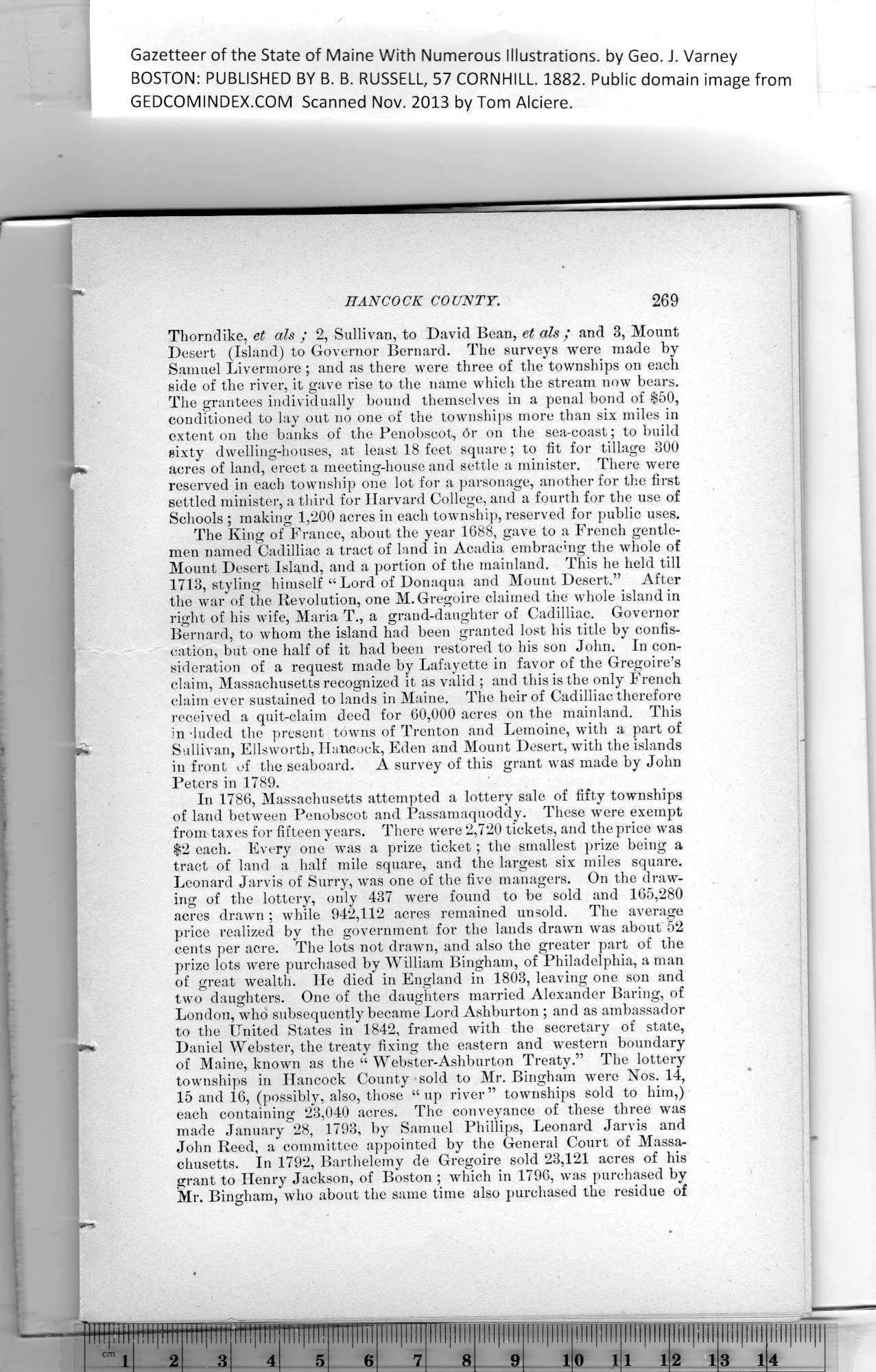|
Gazetteer of the State of Maine With Numerous Illustrations, by Geo. J. Varney
BOSTON. PUBLISHED BY B. B. RUSSELL, 57 CORNHILL. 1882. Public domain image from
Thorndike, et als ; 2, Sullivan, to David Bean, et als ; and 3, Mount
Desert (Island) to Governor Bernard. The surveys were made by
Samuel Livermore ; and as there were three of the townships on each
side of the river, it gave rise to the name which the stream now bears.
The grantees individually bound themselves in a penal bond of $50,
conditioned to lay out no one of the townships more than six miles in
extent on the banks of the Penobscot, dr on the sea-coast; to build
sixty dwelling-houses, at least 18 feet square; to fit for tillage 300
acres of land, erect a meeting-house and settle a minister. There were
reserved in each township one lot for a parsonage, another for the first
settled minister, a third for Harvard College, and a fourth for the use of
Schools ; making 1,200 acres in each township, reserved for jaublic uses.
The King of France, about the year 1688, gave to a French gentle-
men named Cadilliac a tract of land in Acadia embracing the whole of
Mount Desert Island, and a portion of the mainland. This he held till
1713, styling himself “ Lord of Don aqua and Mount Desert.” After
the war of the Revolution, one M.Gregoire claimed the whole island in
right of his wife, Maria T., a grand-daughter of Cadilliac. Governor
Bernard, to whom the island had been granted lost his title by confis-
cation, but one half of it had been restored to his son John. In con-
sideration of a request made by Lafayette in favor of the Gregoire’s
claim, Massachusetts recognized it as valid ; and this is the only French
claim ever sustained to lands in Maine. The heir of Cadilliac therefore
received a quit-claim deed for 60,000 acres on the mainland. This
in duded the present towns of Trenton and Lemoine, with a part of
Sullivan, Ellsworth, Hancock, Eden and Mount Desert, with the islands
in front of the seaboard. A survey of this grant was made by John
Peters in 1789.
In 1786, Massachusetts attempted a lottery sale of fifty townships
of land between Penobscot and Passamaquoddy. These were exempt
from taxes for fifteen years. There were 2,720 tickets, and the price was
$2 each. Every one was a prize ticket; the smallest prize being a
tract of land a half mile square, and the largest six miles square.
Leonard Jarvis of Surry, was one of the five managers. On the draw-
ing of the lottery, only 437 were found to be sold and 165,280
acres drawn; while 942,112 acres remained unsold. The average
price realized by the government for the lands drawn was about 52
cents per acre. The lots not drawn, and also the greater part of the
prize lots were purchased by William Bingham, of Philadelphia, a man
of great wealth. He died in England in 1803, leaving one son and
two daughters. One of the daughters married Alexander Baring, of
London, who subsequently became Lord Ashburton ; and as ambassador
to the United States in 1842, framed with the secretary of state,
Daniel Webster, the treaty fixing the eastern and western boundary
of Maine, known as tbe “ Webster-Ashburton Treaty.” The lottery
townships in Hancock County sold to Mr. Bingham were Nos. 14,
15 and 16, (possibly, also, those “ up river ” townships sold to him,)
each containing 23,040 acres. The conveyance of these three was
made January 28, 1793, by Samuel Phillips, Leonard Jarvis and
John Reed, a committee appointed by the General Court of Massa-
chusetts. In 1792, Barthelemy de Gregoire sold 23,121 acres of his
grant to Henry Jackson, of Boston ; which in 1796, was purchased by
Mr. Bingham, who about the same time also purchased the residue of
PREVIOUS PAGE ... NEXT PAGE
This page was written in HTML using a program written in Python 3.2
|
